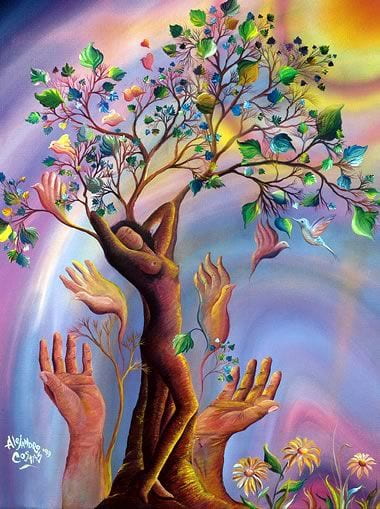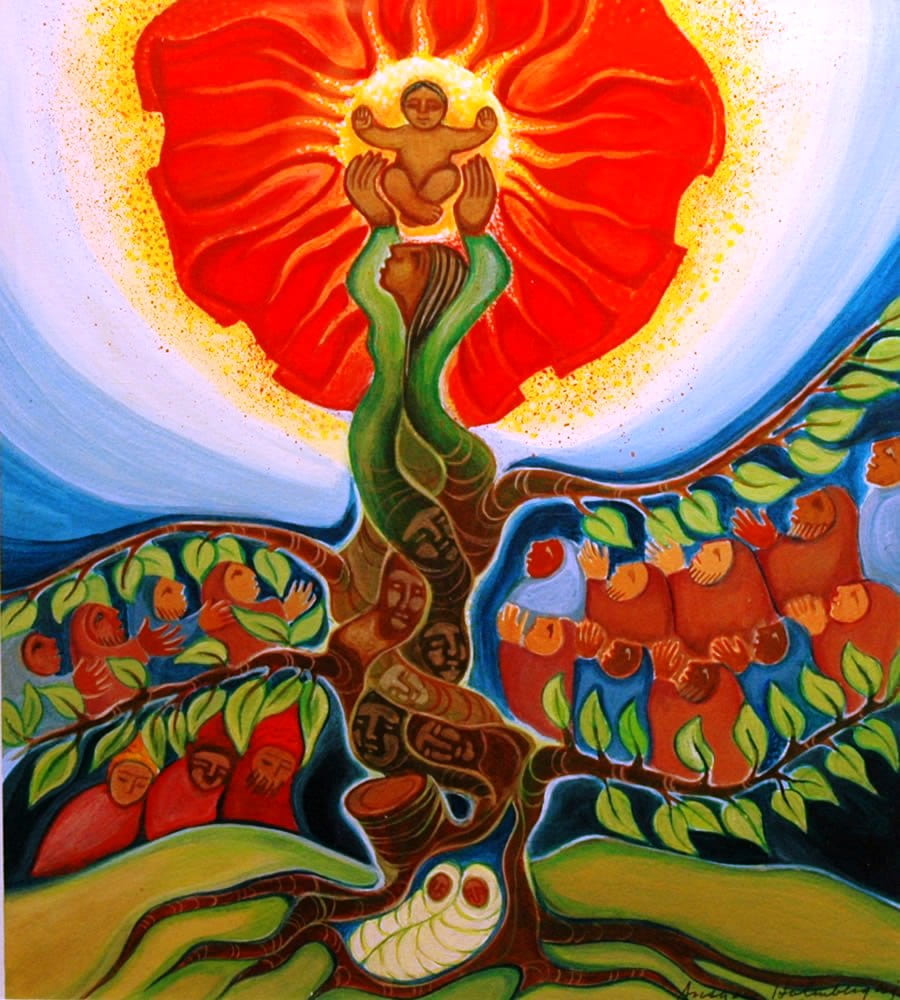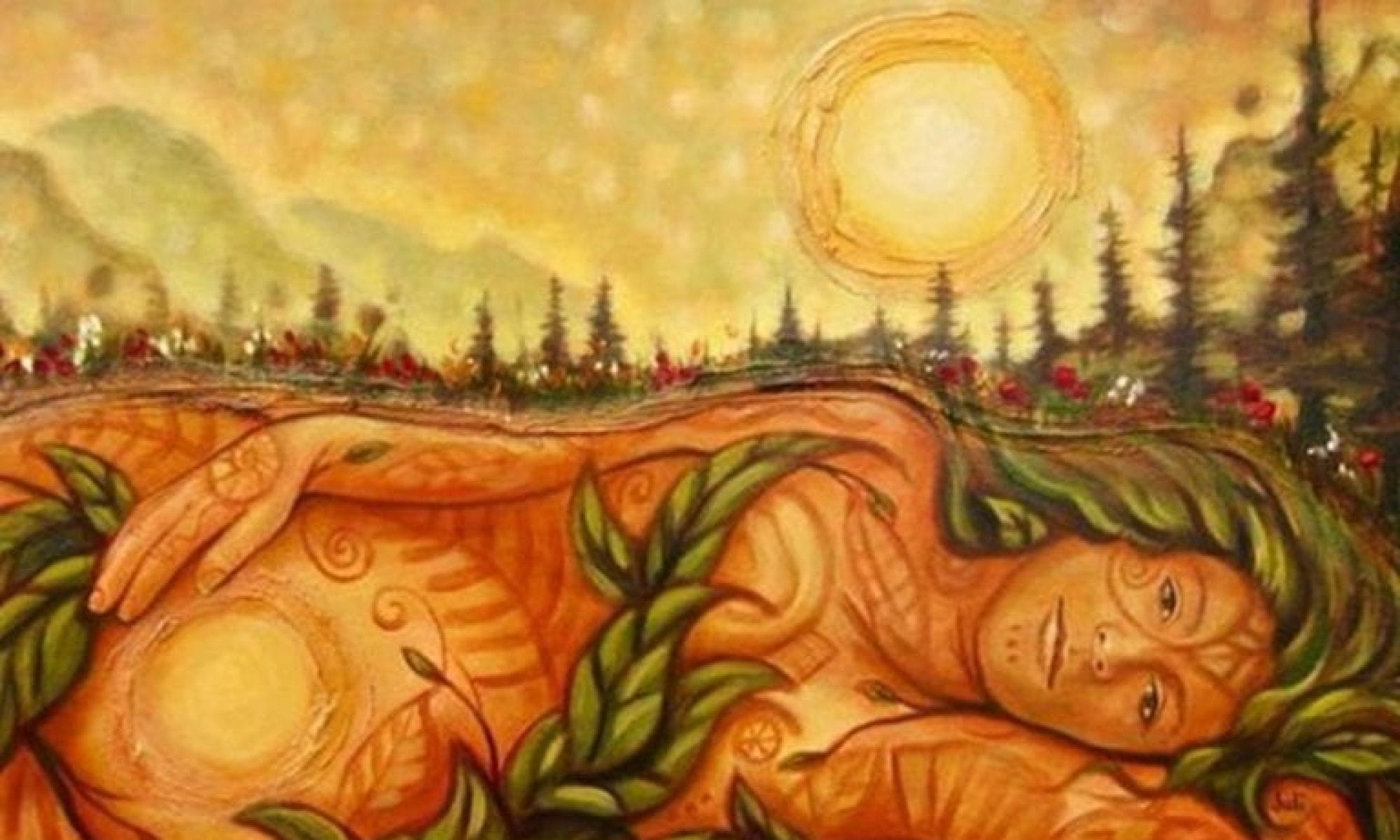….To Save the Mother Earth

El Artista Online | Visionary art, Psychedelic artwork, Female art painting (pinterest.fr)
Ecofeminism grew out of various social movements in the 1970s in the early 1980s including feminist ecological and peace movements ecofeminist Karen Warren is quoted as writing: “Nature is a Feminist Issue”. The material deprivations as well as the cultural losses have a significant impact on the marginalized populations throughout the world, impacting women at higher rate than men.
Ivone Gebara in Ecofeminism: A Latin American Perspective “the question that lies at the heart of most of this is why having now conditions to be emancipated and freer are we developing new forms of barbarism including religious barbarism”? We are highly developed in technology and highly regressive in human ethics and values.
Dr. Gebara spoke about three points: 1) ecofeminism as an echo of feminism 2) beyond theology and 3) a new utopia for our time. I believe that feminism cannot be tempted by masculine and competitive theories which are in love with themselves without searching for structural reform theories and actions towards justice we need to go beyond competition to make possible another world. Ecofeminism’s mission to help save the children but helping to save the world. As an example, in Recife, Brazil there are children literally swimming in garbage. Almost 6,500 children live in the slums. The garbage is so overwhelming that the children try and swim through it to collect aluminum cans to sell to a recycling company. The city of Recife itself is a well-known, high end, tourist destination.
The Chipko movement in India Sunderlal Bahuguna, an eco-activist made an appeal to Mrs. Ghandi to ban the cutting of trees. He shouted, “ecology is the permanent economy”. was organized in the 1970’s as a nonviolent way to bring attention to the protection of trees. The work Chipko means “embrace”. The villagers would “hug” the trees to prevent them from being felled.
Embrace the trees and
Save them from being felled;
The property of our hills,
Save them from being looted.’
A counterpart to Bahuguna in India, is Wangari Maathai in Kenya. She founded the Greenbelt movement in 1977 to plant trees across Kenya, alleviate poverty and end conflict. Behind Wangari Maathai’s motivation was a strong connection between the environmental degradation and poverty and conflict. “Poor people will cut the last tree to cook the last meal she once said the more you degrade the environment the more you dig deeper into poverty.” Maathai. Under her leadership Kenyans planted more than 30 million trees most of which were planted by women the result is that almost 1,000,000 Kenyan women benefited from this campaign for reforestation.

The Yoke of Christ: December 2010
Prolific the Rapper’s call to action slogan is “Our existence is our Resistance”.
“what is fossil fuel?
Continued destruction nothing new
live in a system
Taking our children
Sifting their feelings
till nothing’s true new line I had that money in front of me but I left it because oil money’s dirty if my mother gets disrespected, we’re disconnected these times are hectic and feeling heavy but we still love all things living and suffer from many.

Hi Catherine!
I really liked how you worded your paragraph talking about Dr. Gebara’s points. I agree with you that feminists for women and the earth can and need to do better in and for the future if justice has any chance of becoming a reality for more women and the environment. If we keep competing against each other, how will anything be accomplished? Theories are important, but also is direct action and navigation forward with a plan to make an impact on the oppression and deconstruction on women and the earth.
The artwork that you found for your piece is beautiful, and when I look at it, makes me think of freedom for women and nature to flourish in life.
I think we need more thinkers like Gebara. She speaks directly to the important truth that everyone needs to hear, while making points about her own life, and the realities for so many people like her asking the same questions, and raising the same concerns. She asks the tough questions, but has hope for the future which she expresses through her theory on our new utopia that we need to envision for the future of feminism. She states that “We have some national and international signs that can nourish our dream of a new earth, a new woman and a new man” (Gebara 101). While challenging all of us, she presents hope, in a world full of violence, and suffering. That is what I really cherish about her.
Hi Catherine,
I enjoyed reading your blog post about the several movements of activism led by those marginalized in connection to the oppression of nature. Drawing further upon The Green Belt Movement led by Wangari Maathi, this specific activism was empowering to read. Despite the interrogation and criminalization faced by women at the hands of those seeking to destroy the ecological systems that sustained their survival, those disadvantaged in political power used their own agency in the community to act in environmentalism. Maathi writes, “Tree-planting empowered these women because it was not a complicated thing. It was something that they could do and see the results of. They could, by their own actions, improve the quality of their lives” (2000). As I read these words, I was truly inspired. Often what seems insurmountable can be an action so powerful to unite those around us and improve lives despite the powers of patriarchy that loom above us and threaten to control. Although patriarchy is too a pervasive social construct of Western society, it becomes life threatening to vulnerable communities of the Global South. Vandana Shiva provides an additional example of activism in the Navdanya movement which works to create seed and food sovereignty. She describes how women take on the primary role as savers of the seeds becoming a repository for seed knowledge. Shiva states, “I’ve been so inspired by the fact that women have been able to take knowledge that is theirs, adapt, and evolve it to the new context…. women growing millets are then making products from them. The millets see them through a bad drought year, they don’t need irrigation, they’re good nutrition for their own family, and they’re good income for when they sell it” (Shiva 134). Just as the women of The Green Belt Movement, the women building Navdanya have used their own ability to gather seeds and use their knowledge to develop techniques to sustain the diversity of all life both biological and ecological. Shiva provides the insight, “…you can’t save the planet without equality” (130). Connecting to our previous unit on women representation and state environmentalism, without gender equality in the political sector, environmental degradation will continue to happen as patriarchy and capitalism work together in disempowering the marginalized and generating profit off the material realities of the land which connect in the oppression of women. You include powerful lyrics from Prolific the Rapper’s music video in which he counters the beliefs of those in power. As mining corporations move in with mantras of profit and employment, as does material deprivation and cultural loss. But as depicted in Prolific the Rapper’s lyrics, it is much more than this. Indigenous lands and peoples have countlessly fallen victim to the hands of sanctioned violence. Peaceful protests are framed as aggressive and forceful in hopes of disempowering those whose lives are threatened by ecological degradation. It is not only a loss of culture, but the violence towards women as the connection to land is selfishly ignored and their lives placed in danger through the consumption of hegemonic masculinity. The movements of activism analyzed this week provide evidence that the oppression of nature is linked to the oppression of women and an intersectional approach to ecofeminism is needed as those vulnerable experience detrimental effects as when the land is threatened with harm so too is their survival.
If you are looking to read further into the work of Shiva in addition to previous course material, here is the citation information from an excerpt included in a great book: Shiva, Vandana. “Hand in Hand: Women’s Empowerment and Sustainability.” Why Women Will Save the Planet, 2nd ed., Zed Books, London, UK, 2015, pp. 130–140.
Best,
Kylie Coutinho